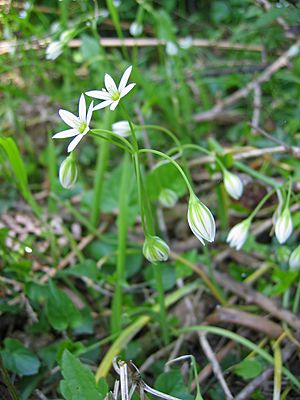Italian garlic facts for kids
Quick facts for kids Italian garlic |
|
|---|---|
 |
|
| Allium pendulinum | |
| Scientific classification | |
| Synonyms | |
|
Allium pendulinum, also known as Italian garlic, is a special type of plant. It is found only in a few places around the Mediterranean Sea. You can find it growing in Sardinia, Sicily, Corsica, and mainland Italy.
About Italian Garlic
Italian garlic is a type of perennial herb. This means it is a plant that lives for more than two years. It grows back year after year without needing to be replanted. It is related to the garlic and onions we eat.
What Italian Garlic Looks Like
This plant is usually quite short, often less than 25 centimeters (about 10 inches) tall. It mostly grows leaves, which are its main feature for much of the year. These leaves often dry up and disappear before the plant starts to flower.
When Italian garlic blooms, it has a unique flower shape. Its flowers grow in a cluster called an umbel. Imagine a small umbrella shape where the flowers hang down. There are usually fewer than 10 flowers in each cluster. Each flower hangs on a long stalk called a pedicel. This drooping or "nodding" look is why it's called pendulinum, which means "hanging down."
The flowers themselves are white. Each white petal, called a tepal, has three thin, clear green lines running through it. The parts that hold pollen, called anthers, are a creamy color. The part of the flower that will become the seed, called the ovary, is green when the plant is flowering.
Where Italian Garlic Grows
Italian garlic is native to specific islands and parts of Italy. It thrives in these areas, which have a Mediterranean climate. This climate usually has mild, wet winters and hot, dry summers. This plant is a unique part of the natural plant life in these regions.

